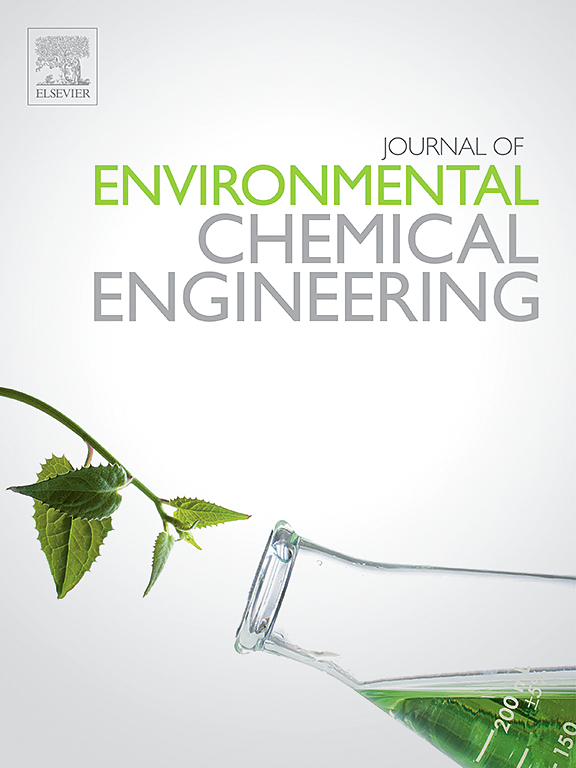使用 K2CO3 固体吸附剂在非等温循环流化床立管中捕获二氧化碳的 CFD 建模
IF 7.4
2区 工程技术
Q1 ENGINEERING, CHEMICAL
引用次数: 0
摘要
本研究探讨了在循环流化床反应器(CFBR)中使用钾基固体吸附剂捕集二氧化碳的问题,这是一项在各行各业都很有前景的技术。研究采用欧拉-欧拉反应多相法,通过数值模拟探索了在使用 K2CO3 吸附剂的三维 CFBR 中捕获二氧化碳的过程。在根据实验数据成功验证了二氧化碳去除浓度模型后,分析了冷却水温度、流速、冷却级之间的距离、冷却管直径和配置等关键参数,以优化 K2CO3 吸附二氧化碳的性能。结果表明,调整这些参数可以提高二氧化碳去除率。降低冷却水温度可提高 K2CO3 的性能,但会增加能耗。提高冷却水流速可略微提高二氧化碳去除率。冷却级间隙的变化对二氧化碳去除率的影响很小,但较大的冷却管直径可通过增加传热表面积来提高二氧化碳去除率。不同的立管配置会影响二氧化碳的去除率,交错布置的冷却管显示出更佳的颗粒分布和二氧化碳去除效率。总体而言,降低温度可通过有利地改变反应平衡来改善 K2CO3 的性能。本文章由计算机程序翻译,如有差异,请以英文原文为准。
CFD modeling of CO2 capture in a non-isothermal circulating fluidized bed riser using K2CO3 solid sorbent
The study investigates the use of potassium-based solid sorbents for CO2 capture in a circulating fluidized bed reactor (CFBR), a promising technology in various industries. The numerical simulations were employed to explore the process of CO2 capture in a three-dimensional (3D) CFBR using K2CO3 adsorbents with a reactive multiphase Eulerian-Eulerian approach. After successfully validating the model for CO2 removal concentration with the experimental data, the key parameters like cooling water temperature, flow rate, distance between cooling stages, diameter, and configuration of cooling tubes were analyzed to optimize K2CO3 performance for CO2 adsorption. Results show adjustments to these parameters can enhance CO2 removal rates. Lowering cooling water temperature improves K2CO3 performance but increases energy consumption. Increasing the cooling water flow rate slightly boosts CO2 removal efficiency. Changes in cooling stage gaps have minimal impact on CO2 removal, but larger cooling tube diameters enhance CO2 removal rates by increasing heat transfer surface area. Different riser configurations affect CO2 removal, with staggered cooling tube arrangements showing superior particle distribution and CO2 removal efficiency. Overall, decreasing temperature improves K2CO3 performance by favorably shifting reaction equilibrium.
求助全文
通过发布文献求助,成功后即可免费获取论文全文。
去求助
来源期刊

Journal of Environmental Chemical Engineering
Environmental Science-Pollution
CiteScore
11.40
自引率
6.50%
发文量
2017
审稿时长
27 days
期刊介绍:
The Journal of Environmental Chemical Engineering (JECE) serves as a platform for the dissemination of original and innovative research focusing on the advancement of environmentally-friendly, sustainable technologies. JECE emphasizes the transition towards a carbon-neutral circular economy and a self-sufficient bio-based economy. Topics covered include soil, water, wastewater, and air decontamination; pollution monitoring, prevention, and control; advanced analytics, sensors, impact and risk assessment methodologies in environmental chemical engineering; resource recovery (water, nutrients, materials, energy); industrial ecology; valorization of waste streams; waste management (including e-waste); climate-water-energy-food nexus; novel materials for environmental, chemical, and energy applications; sustainability and environmental safety; water digitalization, water data science, and machine learning; process integration and intensification; recent developments in green chemistry for synthesis, catalysis, and energy; and original research on contaminants of emerging concern, persistent chemicals, and priority substances, including microplastics, nanoplastics, nanomaterials, micropollutants, antimicrobial resistance genes, and emerging pathogens (viruses, bacteria, parasites) of environmental significance.
 求助内容:
求助内容: 应助结果提醒方式:
应助结果提醒方式:


